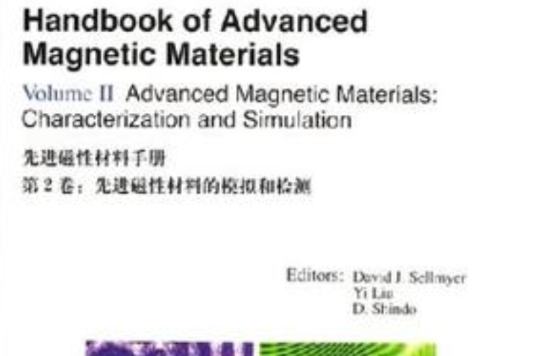《先進磁性材料手冊第2卷》是2005年7月清華大學出版社出版的圖書,作者是(美)塞爾米厄、(美)劉義、(美)沙因多。
基本介紹
- 書名:先進磁性材料手冊第2卷
- 作者:(美)塞爾米厄(美)劉義(美)沙因多
- ISBN:9787302087014
- 頁數:604
- 定價:139.00元
- 出版社:清華大學出版社
- 出版時間:2005-7
- 裝幀:簡裝本
- 副標題:先進磁性材料的模擬和檢測
內容簡介,圖書目錄,
內容簡介
本書的目的是對磁性材料研究的新近進展提供一種全面的理解。本書共分四卷,每一卷集中論述一個具體的研究領域。每一章首先對該章的基本概念和重要觀念進行闡述,然後從實驗和理論方面進行詳細地說明,最後介紹該領域的發展前景以及新的思想。書中提供了詳盡的參考文獻,可供研究人員參考。
原子磁矩和巡迴磁模型的建立墊定了我們對磁性的理解。記算是有效的方法來驗正理論及予測新性能。在此過程中建立模型和其邊界條件需要對材料的幾何形狀,結構和性能進行準確的測量。第2卷收集總結磁性理論、 模擬、結構和性能的測量的最新成果。
本書的讀者對象為研究生和相關專業的研究人員。
圖書目錄
Forward
Preface
List of Contributors
1 Adanced Magnetic Force Microscopy Tips for Imaging Domains
1.1 Introduction1
1.2 Magnetic Force Microscopy
1.2.1 Basic Operating Principles of MFM
1.2.2 Force Gradient Detection
1.2.3 Sensitivity and Resolution
1.2.4 Tip\|Sample Interaction4
1.2.5 Force Sensor
1.3 Development of Advanced MFM Tips
1.3.1 High Coercivity CoPt MFM Tips
1.3.2 Superparamagnetic and Low Stray Magnetic Field MFM Tips
1.3.3 Electron\|Beam\|Induced\|Deposited (EBID)MFM Tips
1.3.4 oint\|Dipole MFM Tips
1.3.5 ocused Ion Beam Milling MFM Tips
References
2 Lorentz Microscopy and Holography Characterization of Magnetic Materials
2.1 Introduction
2.2 Instrumentation
2.3 Analytical Electron Microscopy for Structure Characterization
2.3.1 Outline of Current Analytical Electron Microscopy
2.3.2 Thickness Measurement by EELS
2.3.3 Elemental Mapping with EDS
2.4 Lorentz Microscopy on Magnetic Domain Structure
2.4.1 Principles of Lorentz Microscopy
2.4.2 Lorentz Microscopy Using Conventional Transmission Electron Microscopes
2.4.3 Lorentz Microscopy Using Scanning Transmission Electron Microscopes
2.5 Principles and Application of Electron Holography
2.5.1 Principles of Electron Holography
2.5.2 Practice of Electron Holography
2.5.3 Application of Electron Holography
2.6 Concluding Remarks
References
3 Characterization of Magnetic Materials by Means of Neutron Scattering
3.1 Introduction
3.1.1 Cross Section Formalism
3.1.2 Polarized Neutron Beam Instrumentation
3.1.3 The Polarization of the Scattered Beam
3.2 Elastic Magnetic Scattering
3.2.1 SmallAngle Scattering
3.2.2 Neutron Diffraction
3.2.3 Reflection of Neutrons from Magnetic Surfaces and Interfaces
3.3 Inelastic Magnetic Scattering
3.3.1 Studies of Elementary Excitations by Tripleaxis Spectroscopy
3.3.2 Detection of Slow Motions by Neutron Spin Echo
3.4 Summaries
References
4 Advanced Transmission Electron Microscopy of Nanostructured Magnetic Materials
4.1 Introduction
4.2 Specimen Preparation
5 M *ssbauer Spectroscopy Characterization of Soft Magnetic Nanocrystalline Alloys
6 Atom Probe Characterization of Microstructures of Nanocrystalline and Nanocomposite Magnetic Materials
7 ItinerantElectron Metamagnetism310
8 Modeling of Hysteresis in Magnetic Materials372
9 Coarse-graining and Hierarchical Simulation of Magnetic Materials: the Fast Multipole Method
10 Numerical Simulation of Quasistatic and Dynamic Remagnetization Processes with Special Applications to Thin Films and Nanoparticles
11 Preisach Model and Simulation of Relaxation Kinetics
12 Antiferromagnetism of Mn Alloys
Preface
List of Contributors
1 Adanced Magnetic Force Microscopy Tips for Imaging Domains
1.1 Introduction1
1.2 Magnetic Force Microscopy
1.2.1 Basic Operating Principles of MFM
1.2.2 Force Gradient Detection
1.2.3 Sensitivity and Resolution
1.2.4 Tip\|Sample Interaction4
1.2.5 Force Sensor
1.3 Development of Advanced MFM Tips
1.3.1 High Coercivity CoPt MFM Tips
1.3.2 Superparamagnetic and Low Stray Magnetic Field MFM Tips
1.3.3 Electron\|Beam\|Induced\|Deposited (EBID)MFM Tips
1.3.4 oint\|Dipole MFM Tips
1.3.5 ocused Ion Beam Milling MFM Tips
References
2 Lorentz Microscopy and Holography Characterization of Magnetic Materials
2.1 Introduction
2.2 Instrumentation
2.3 Analytical Electron Microscopy for Structure Characterization
2.3.1 Outline of Current Analytical Electron Microscopy
2.3.2 Thickness Measurement by EELS
2.3.3 Elemental Mapping with EDS
2.4 Lorentz Microscopy on Magnetic Domain Structure
2.4.1 Principles of Lorentz Microscopy
2.4.2 Lorentz Microscopy Using Conventional Transmission Electron Microscopes
2.4.3 Lorentz Microscopy Using Scanning Transmission Electron Microscopes
2.5 Principles and Application of Electron Holography
2.5.1 Principles of Electron Holography
2.5.2 Practice of Electron Holography
2.5.3 Application of Electron Holography
2.6 Concluding Remarks
References
3 Characterization of Magnetic Materials by Means of Neutron Scattering
3.1 Introduction
3.1.1 Cross Section Formalism
3.1.2 Polarized Neutron Beam Instrumentation
3.1.3 The Polarization of the Scattered Beam
3.2 Elastic Magnetic Scattering
3.2.1 SmallAngle Scattering
3.2.2 Neutron Diffraction
3.2.3 Reflection of Neutrons from Magnetic Surfaces and Interfaces
3.3 Inelastic Magnetic Scattering
3.3.1 Studies of Elementary Excitations by Tripleaxis Spectroscopy
3.3.2 Detection of Slow Motions by Neutron Spin Echo
3.4 Summaries
References
4 Advanced Transmission Electron Microscopy of Nanostructured Magnetic Materials
4.1 Introduction
4.2 Specimen Preparation
5 M *ssbauer Spectroscopy Characterization of Soft Magnetic Nanocrystalline Alloys
6 Atom Probe Characterization of Microstructures of Nanocrystalline and Nanocomposite Magnetic Materials
7 ItinerantElectron Metamagnetism310
8 Modeling of Hysteresis in Magnetic Materials372
9 Coarse-graining and Hierarchical Simulation of Magnetic Materials: the Fast Multipole Method
10 Numerical Simulation of Quasistatic and Dynamic Remagnetization Processes with Special Applications to Thin Films and Nanoparticles
11 Preisach Model and Simulation of Relaxation Kinetics
12 Antiferromagnetism of Mn Alloys

